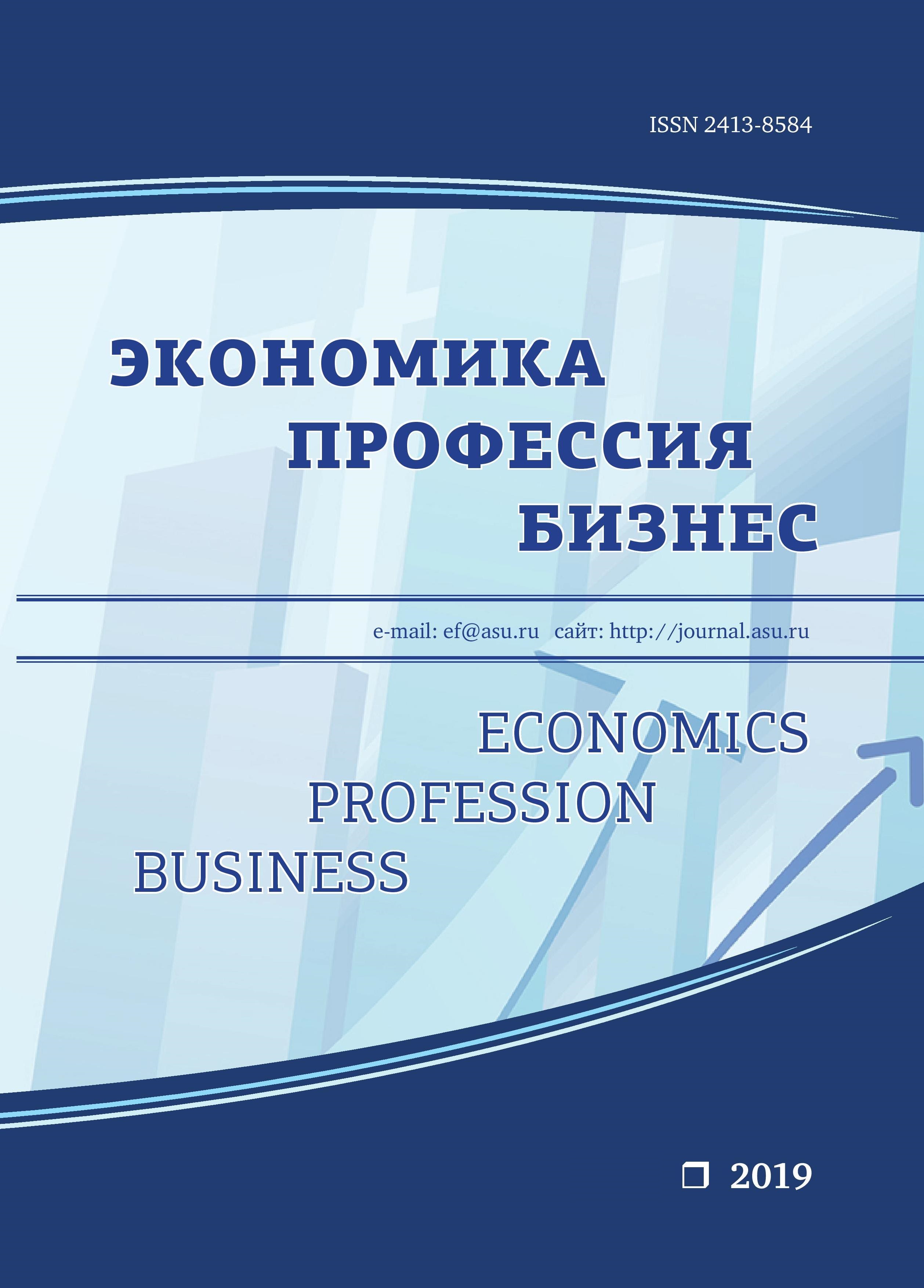STRATEGY FOR SOCIO-ECONOMIC DEVELOPMENT OF THE ALTAI KRAI UP TO 2035: EXPERT ASSESSMENT AND PROPOSALS TO IMPROVE
Abstract
The results of the examination of the draft “Strategy for socio-economic development of the Altai Krai up to 2035” are presented. The authors assess the draft strategy as a whole, as well as its individual sections. The advantages and shortcoming of the draft are highlighted. A new structure of the document is proposed. The reasoned proposals for improving each of the sections of the draft strategy are given.
Downloads
Metrics
References
Вишневский А. Г., Щербакова Е. М. Демографические тормоза экономики // Вопросы экономики. 2018. № 6. С. 48-70.
Габдуллин Н. М. Современные подходы и методы измерения человеческого капитала // Вопросы инновационной экономики. 2018. Том 8. № 4. С. 785-798. DOI: 10.18334/vinec.8.4.39709.
Иконникова О. В. Качество жизни населения Архангельской области и проблемы его оценки // Российское предпринимательство. 2013. Том 14. № 22. с. 150-153 [Электронный ресурс]. URL: https:// creativeconomy.ru/lib/7912.
Косьмина Е. А., Дубенская Е. С. О методологических ориентирах исследования качества жизни // Российское предпринимательство. 2014. Том 15. № 2. С. 98-107 [Электронный ресурс]. URL: https:// creativeconomy.ru/lib/8455.
Нестерова О. А., Пожарницкая О. В. Оценка благосостояния с позиции устойчивого человеческого развития: возможности международных индексов // Вопросы инновационной экономики. 2018. Том 8. № 3. С. 335-348. DOI: 10.18334/vinec.8.3.39338.
Соболева С. В., Чудаева О. В. Демографический потенциал Сибири // Формирование благоприятной среды для проживания в Сибири / под ред. акад. РАН В. В. Кулешова. Новосибирск: ИЭОПП СО РАН, 2010. С. 53-95.
Трансформационные процессы и формирование конкурентных преимуществ в Алтайском крае / под ред. А. Я. Троцковского; ФАНО СО РАН, ИЭОПП СО РАН, Алтайский гос. ун-т и др. Новосибирск: Изд-во ИЭОПП СО РАН, 2017. 424 с.
Троцковский А. Я. Дисбалансы в пространственном развитии Алтайского края в контексте реализации долгосрочной стратегии // Экономика. Профессия. Бизнес. 2018. № 4. С. 75-85. DOI: 10.14258/201856.
10. Федорова О. И., Зуева Е. Г. Накопление и реализация человеческого капитала в новых условиях: возможности и ограничения // Креативная экономика. 2018. Том 12. № 10. с. 1649-1660. DOI: 10.18334/ ce.12.10.39434.
Ширинкина Е. В. Человеческий капитал и рынок труда в цифровом развитии российской экономики // Экономика труда. 2019. Том 6. № 1. С. 103-112. DOI: 10.18334/et.6.1.40099.
REFERENCES
Becker G. S. (1993) Human Capital: A Theoretical and Empirical Analysis with Special Reference to Education. 3rd Edition. Chicago and London: The University of Chicago Press, 416. DOI: 10.7208/ chicago/9780226041223.001.0001.
Vishnevsky, A. G. & Scherbakova, E. M. (2018) Demographic brakes of the economy. Voprosy Ekonomiki, 6, 48-70. DOI: 10.32609/0042-8736-2018-6-48-70 (in Russian).
Gabdullin, N. M. (2018) Modern approaches and methods of measuring human capital. Russian Journal of Innovation Economics, vol. 8, 4, 785-798. DOI: 10.18334/vinec.8.4.39709 (in Russian).
Ikonnikova, O. V. (2019) Life quality of the of the Arkhangelsk region population and problems of its evaluation. Russian Journal of Entrepreneurship, vol. 14, 22, 150-153. URL: https://creativeconomy.ru/lib/7912 (in Russian).
Kosymina, Е. A. & Dubenskaya, Е. S. (2014) On methodological objectives of life quality studying. Russian Journal of Entrepreneurship, vol. 15, 2, 98-107. URL: https://creativeconomy.ru/lib/8455 (in Russian).
Nesterova, O. A. & Pozharnickaya, O. V. (2018) Assessing well-being from the perspective of sustainable human development: the potential of international indices. Russian Journal of Innovation Economics, vol. 8, 3, 335-348. DOI: 10.18334/vinec.8.3.39338 (in Russian).
Soboleva, S. V. & Chudaeva, O. V. (2010) Demographic potential of Siberia. The Formation of favourable dwelling conditions in Siberia / edited by Acad. V. V. Kuleshov. Novosibirsk: IEIE SB RAS, 53-95 (in Russian).
Transformational processes and the formation of competitive advantages in the Altai Territory (2017) / edited by A. Ya. Trotskovsky. Novosibirsk: IEIE SB RAS, 424 (in Russian).
Trotskovsky, A. Ya. (2018) Imbalances in the Altai Territory spatial development in context of long-term strategy. Economics. Profession. Business, 4, 75-85. DOI: 10.14258/201856 (in Russian).
Fedorova, O. I. & Zueva, Е. G. (2018) Accumulation and realization of human capital in new conditions: opportunities and limitations. Creative Economy, vol. 12, 10, 1649-1660. DOI: 10.18334/ce.12.10.39434 (in Russian).
Shirinkina Е. V. (2019) Human capital and the labour market in the digital development of the Russian economy. Russian Journal of Labor Economics, vol. 6, 1, 103-112. DOI: 10.18334/et.6.1.40099 (in Russian).
Economics Profession Business is a golden publisher, as we allow self-archiving, but most importantly we are fully transparent about your rights.
Authors may present and discuss their findings ahead of publication: at biological or scientific conferences, on preprint servers, in public databases, and in blogs, wikis, tweets, and other informal communication channels.
Economics Profession Business (EPB) allows authors to deposit manuscripts (currently under review or those for intended submission to EPB) in non-commercial, pre-print servers such as ArXiv.
Authors who publish with this journal agree to the following terms:
- Authors retain copyright and grant the journal right of first publication with the work simultaneously licensed under a Creative Commons Attribution License that allows others to share the work with an acknowledgement of the work's authorship and initial publication in this journal.
- Authors are able to enter into separate, additional contractual arrangements for the non-exclusive distribution of the journal's published version of the work (e.g., post it to an institutional repository or publish it in a book), with an acknowledgement of its initial publication in this journal.
- Authors are permitted and encouraged to post their work online (e.g., in institutional repositories or on their website) prior to and during the submission process, as it can lead to productive exchanges, as well as earlier and greater citation of published work (See The Effect of Open Access).









